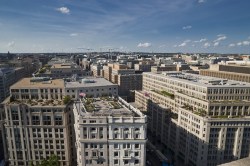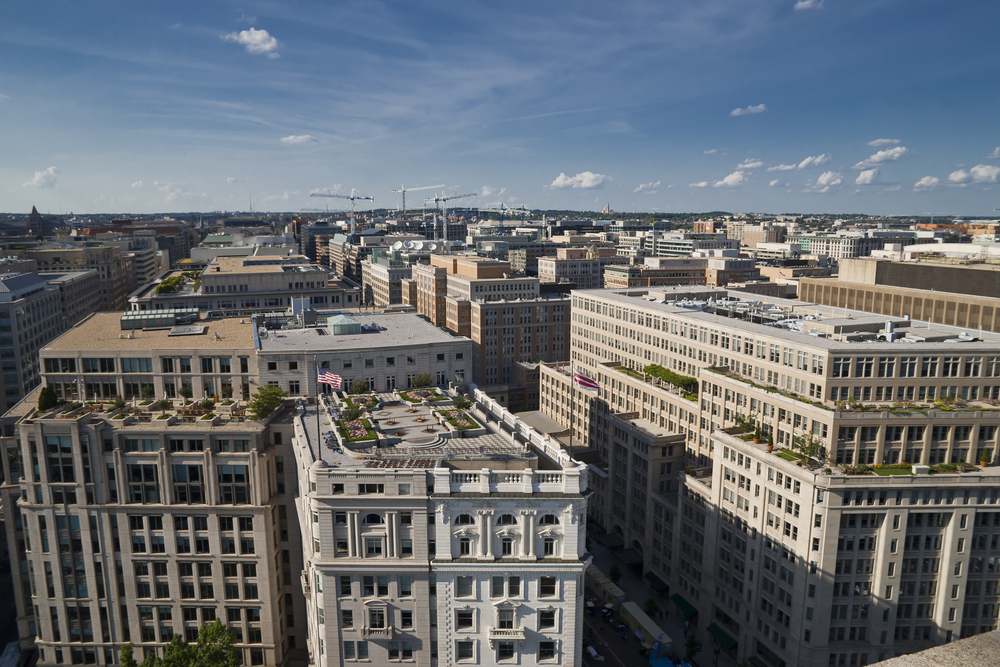
ShutterstockLow – rise – er …
If you’ve ever looked at the skyline of Washington, D.C., you know what it’s lacking: tall buildings. While other cities of D.C.’s population size and economic stature have at least a few high-rise office and apartment buildings in central locations, D.C. is just a collection of squat boxes. In fact, it’s illegal to build anything over 130 feet tall. That may soon change, however — and it’s about time.
A widely cited urban myth holds that D.C. law prohibits buildings taller than the Capitol dome. In fact, preserving views of the Capitol and Washington Monument is one of the law’s few virtues, but the height restriction is actually the result of some old-fashioned NIMBYism. Height restrictions were first approved by Congress in 1899 in response to neighbors’ complaints about construction of a 160-foot-tall apartment building. In 1910, Congress passed the Height of Buildings Act, which established that the height of a building on a commercial street cannot exceed the width of the street by more than 20 feet and cannot exceed 130 feet overall. As a result, the tallest office and apartment buildings downtown are typically not more than 12 stories.
As demand to live and work in Washington has risen in recent years, after decades of decline, academics and journalists who favor smart growth have started to examine the law’s unintended consequences. Critics include Harvard economist Edward Glaeser, Slate’s Matthew Yglesias, and Ryan Avent of The Economist. The Height Act has also come under critical scrutiny in The Atlantic Cities, Greater Greater Washington, and Washington City Paper, which called for repealing the law in a 2010 cover story. On Nov. 8, D.C.’s delegate to Congress, Eleanor Holmes Norton, and Rep. Darrell Issa (R-Calif.), chair of the House Committee on Oversight and Government Reform, requested a study of the Height Act’s costs and benefits.
The case against the law is mostly one of straightforward economics. If you limit the supply of something, including space, you will increase its price. D.C. is one of the most expensive cities in the country for housing and hotel rooms. Downtown D.C. has the second highest average rental price for office space in the U.S., after Midtown Manhattan. Consequently, residential and commercial development has been dispersed across the D.C. region, rather than being concentrated in the downtown core. Translation: The Height Act causes sprawl.
Cross the Potomac River from Washington to Arlington, Va., and you will see a mass of high-rise office and apartment towers. Some of the tenants may be looking for the commanding views of a 30th story window, but for the most part, they’re just looking for cheaper rents than they can find in D.C. proper. And if you care about minimizing car travel and greenhouse gas emissions, that’s bad.
Even though Arlington has a metro line, it is not as environmentally efficient a place to locate offices as downtown D.C. In Washington’s hub-and-spoke mass transit system, downtown is the hub and Arlington is one of many spokes. That means commuters to Arlington from other spokes in the region face a much longer journey by mass transit than by driving. The result? Wasted time, more cars on the road, and more people with an incentive to live out in the Virginia suburbs, closer to their offices.
It gets worse than Arlington. Tyson’s Corner, Va., is a massive exurban edge city of high-rise offices and shopping malls the size of football stadiums, and the Metro does not go there at all. As Yglesias writes, “[T]he existing regional transportation infrastructure already goes downtown and we should be maximizing the value of that infrastructure.”
In the city itself, high rents for housing and offices are not the Height Act’s only drawback. It may even be to blame for downtown D.C.’s notoriously mediocre and uninspiring architecture. And a 2009 M.I.T. master’s thesis, reported in Washington City Paper, found that the law “puts a damper on the kind of commercial vitality that comes with residential density.” By nightfall, its restaurants and stores are mostly closed, due to lack of demand.
So why would D.C. want to keep the height restrictions around? In a word: nostalgia.
Last week, NRDC’s prolific urbanist writer (and sometime Grist contributor) Kaid Benfield penned “The Urbanist Case for Keeping D.C.’s Height Restrictions.” Benfield, who has lived in D.C. for several decades, argues that the district’s character is inextricably tied to its low-rise residential neighborhoods and views of landmarks. “The importance of Washington’s vistas and distinctiveness should not be underestimated,” he writes.
But the height restriction can cause the city to lose its identity in other ways. Lydia DePillis, writing in Washington City Paper, says that the MIT study showed that “[The Height Act] also puts more development pressure on older buildings — when you can’t build up, you demolish buildings in desirable areas that are shorter than they’re allowed to be, even if they’re still perfectly good structures.”
D.C. is also seeing massive out-migration of African-Americans, who long made up a majority of District residents, due to rising housing prices. If the height restrictions aren’t lifted, the cost of living will continue to go up, and D.C. could lose much of its diversity. “If D.C. grows too affluent, providing for a luxury market but not the density that makes low-income housing possible, too, then it won’t be the District anymore,” writes Kriston Capps in Architect magazine.
Benfield claims that taller buildings would not increase affordability. “If affordability were closely related to building height and density, New York City and San Francisco would be the two most affordable big cities in America,” he writes. He is getting causality backwards. New York and San Francisco have tall buildings because the high demand to locate there has driven up prices to the point that it is profitable to build upwards. They are still expensive because there are not enough tall buildings, or not enough land left on which to build them.
To prove that D.C. has not lost economic growth due to the Height Act, Benfield writes, “Washington is the richest and best-educated metro area in America.” But the problem with D.C.’s height restriction is not that it necessarily drives economic activity to other regions, it’s that it clearly drives people and jobs to the suburbs. D.C.’s suburbs are much richer than the city itself.
Benfield is right to note the slight perversity of urbanists attacking already dense cities such as New York and D.C. for not being even denser still, when by far the bigger environmental problem is much lower density in most suburbs and Sunbelt cities. But none of this is a compelling enough reason to keep the height restrictions entirely in place.
The Height Act is an outdated blunt instrument — and anyway, Congress need not dictate to D.C. how tall its buildings may be. Let the residents of the District, through the democratic process, determine the tradeoff between being able to see the Capitol from their roof and the cheaper rents and greater tax revenues that lifting the height restrictions would bring.



